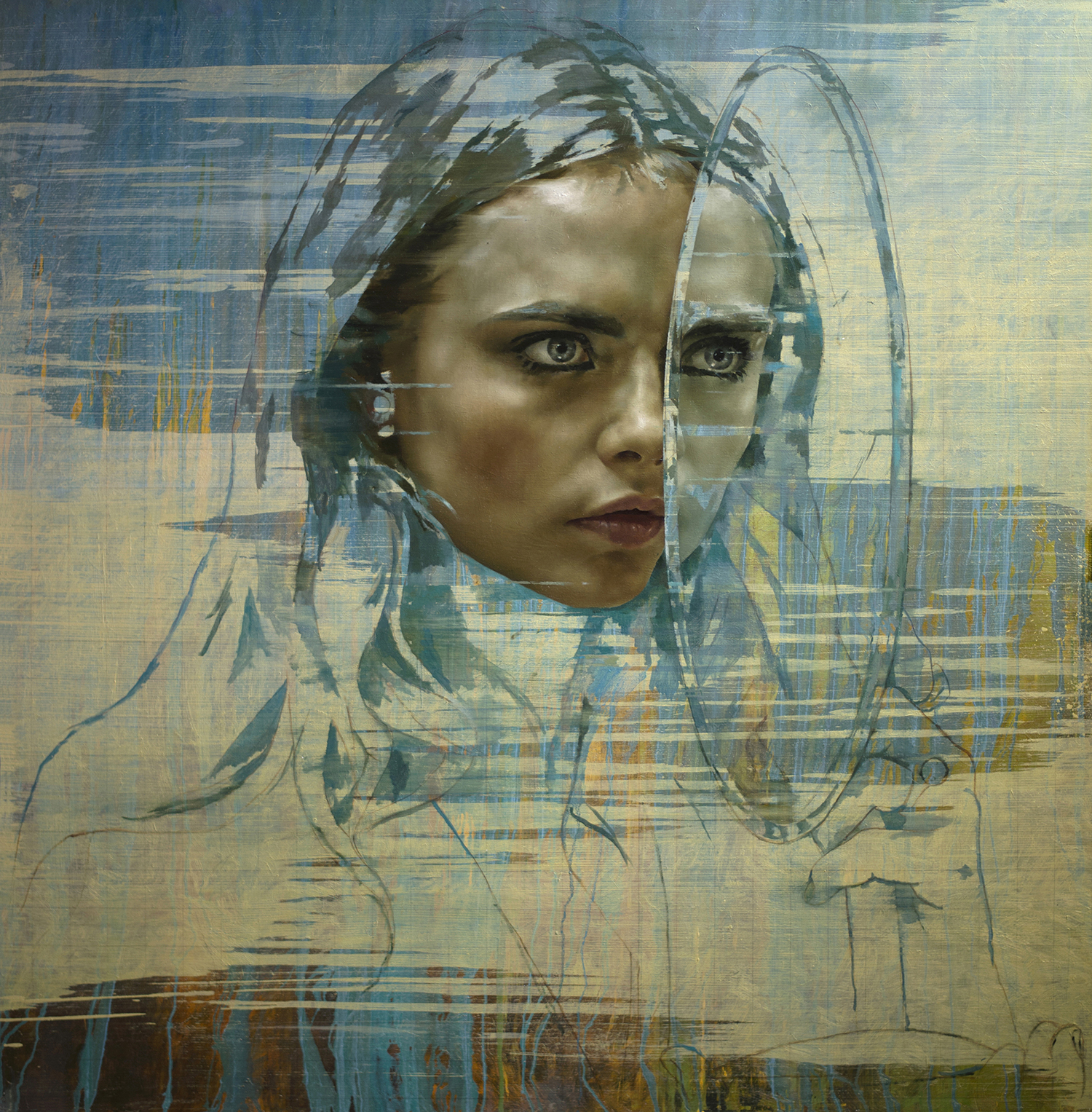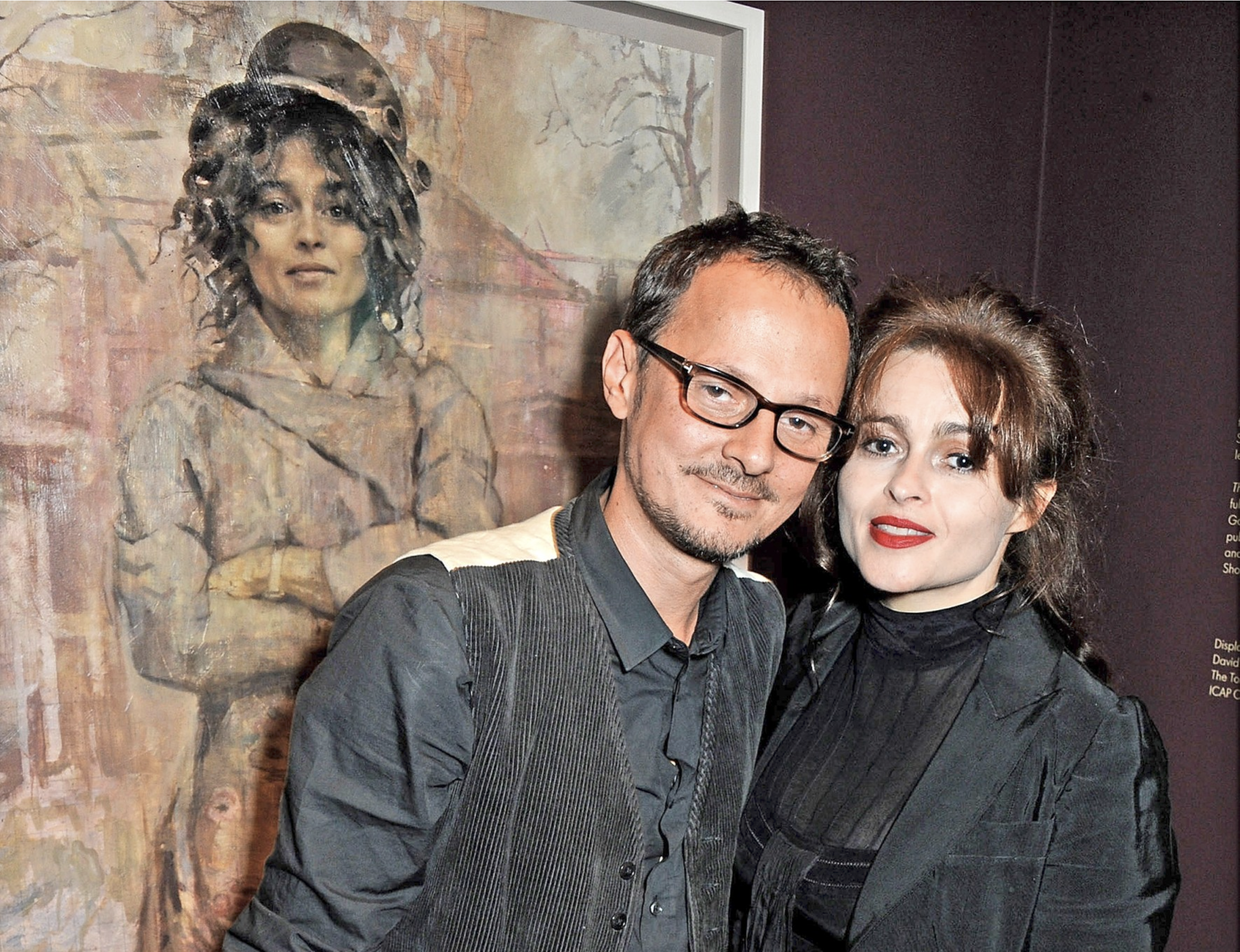the times
He didn’t go to art school, but royalty, supermodels and prime ministers all want Yeo to capture their likeness. So what happened when our art critic sat for him?

©Michael Leckie for The Times
Arriving at Jonathan Yeo’s west London studio in the pouring rain, I am expecting bare floorboards and north-lit windows. What I get is a slick, hangar-like space that would do for a particularly cool tech start-up. But then the star portraitists of history have always had digs fit for a king. Joshua Reynolds took a townhouse on Leicester Fields. John Everett Millais built himself a Kensington mansion. You can’t expect the great and the good to climb the stairs to a garret.
Yeo has painted everyone from the Duke of Edinburgh and the livewire model Cara Delevingne to David Attenborough, Grayson Perry, Nicole Kidman and the Queen (back when she was the Duchess of Cornwall). And, as of now, me.

Cara VI (mirror)
I’m here to talk to him about his new BBC Maestro online course on portrait painting. He joins a starry faculty: Lee Child on thrillers, Julia Donaldson on children’s picture books, Brian Cox on acting, …I’ve seen the first few episodes and it’s slick, stylish and stimulating.
Dumbing down? There is a huge audience set on swotting up. The most listened-to podcast on the BBC is Melvyn Bragg’s In Our Time. The Rest Is History, presented by Tom Holland and Dominic Sandbrook, can’t get episodes out fast enough. Vermeer: The Greatest Exhibition, with its scholarly segments on the camera obscura and Jesuitical practice in the 17th century, took more than £1 million at the UK box office.
There is a vast appetite for intelligent programming about history, culture, art and science with glossy (not budget Open University) production values. The portrait series has been filmed in Yeo’s studio, so you’ll see everything I saw. Only without the scented candles. You can subscribe to just Yeo or take out an annual subscription to all Maestro courses.
This isn’t paint-by-numbers and it’s certainly not Bob Ross’s The Joy of Painting or Tony Hart teaching you to do Stonehenge in chalks. Even if you have no intention of picking up a paintbrush, I’d recommend the series. It’s a show that teaches you how to see as well as what to do. It’ll change the way you look at portraits and invigorate gallery visits.
Yeo didn’t go to art school. He was at a “very academic school, a very straight one” (Westminster), and left at the beginning of the Nineties when there was “very little painting being done, it was so out of fashion”. It was the age of “conceptual art, video art, minimalism”. In the year after school he tried to make a living painting, “which I failed miserably at because I didn’t know what I was doing, and I had no contracts or anything”.

©Michael Leckie for The Times
He went instead to study film, then in his early twenties became very ill with lymphatic cancer. A year of treatment “made me even more pig-headed and determined to make a go of it. And the advantage of having had cancer is that no one wants to say no to you, no one wants to trample on your dreams.” He talks of early “pity” commissions for family friends that went “surprisingly well”. That brought in “a trickle of work, which got me through my twenties at a time when most people are forced to give up and get a proper job”. From pity portraits it was on to prime ministers, Oscar winners, supermodels, knights of the realm and the American actor Giancarlo “Breaking Bad” Esposito, who is Yeo’s guinea-pig sitter for the Maestro series.
From a Maestro watcher’s point of view, it’s a boon that Yeo isn’t art school-trained. Didn’t stop Yeo, shouldn’t stop you. I put it to him that, as an outsider, he’s on our side. “It’s a funny thing, that, isn’t it? Because almost every artist I know — even the ones I see as being very establishment, very inside, showing in big commercial galleries — [they] all think of themselves as being outside, in a way, like they’ve broken into it [the art world] somehow.” He discusses the insider/outsider feeling in the series. Forget external obstacles. “The only barriers are in your head.”

Portraiture, Yeo says, is a “unique way of getting to know someone”. Does he keep up a conversation or maintain studio silence? He says conversation happens naturally. He tries not to have “massively long sessions”. An hour and a half is a “good sweet spot” for making progress. Actors and politicians, although used to being looked at, may need time to drop their “professional mask”. When he painted Michael Parkinson, Parky, interviewer in excelsis, said: “You know what you do? When I’m talking, you don’t say anything, you just smile and nod, maybe raise your eyebrows.” Interviewer and portrait painter were both leaving space for their subject to reveal themselves.
When I sit for Yeo after our interview, I enjoy the chat but also settle into the silences. On a run-around working weekday, it is restful just to sit still. Too much silence, however, can be chilling. Yeo is critical of Lucian Freud in the series and he comes up again in the interview. “If you don’t talk to people at all, they end up looking like Lucian’s paintings. He used to paint in silence and then take them out to the Wolseley for dinner afterwards. But for me, I think you want to see the spark and often you get ideas from talking to people. Quite often the little quiet narratives in a painting come from conversations.”
Do people end up treating sittings like a therapy session or confession? “Not always,” Yeo says. “But often. It tends to happen late in the painting after, say, half a dozen times.” The studio is “a slightly bonkers space but it’s a sort of safe space too. There’s no one else in the room. I’m not judging them, I’m not really reacting very much at all. I’m trying to work and I think that also kind of encourages people to share things.”

Girl Reading (Malala Yousafzai)
He bumped into Andrew Lloyd Webber recently, having not seen him for years. He came up to Yeo and it was as if they had just “picked up from where we left off”. Lloyd Webber is a famously shy person, but, Yeo says, “fascinating and very knowledgeable and geeky about art”. If drawing people out is one part of the job, discretion is another. “I’ve never done a book telling everyone’s secrets — which has been suggested a few times. I think if I did that, if I started telling people what everyone said, then people would stop coming.”
Yeo has painted the very beautiful — portraits of Sienna Miller and Lily Cole hang in the studio — as well as sitters less obviously ravishing. How does he strike the balance between the faithful warts-and-all likeness and the flattery-will-get-you-everywhere portrait?

©Michael Leckie for The Times
“Obviously, the classical job of portraiture was to recall what someone looked like. There was no other way of knowing. Therefore, if you could incentivise the artist to make you look better, then that’s what people would assume you looked like. As soon as photography came around, that wasn’t the case. So yes, you might try to get people on a good day rather than a bad day but if you lie about someone, that’s going to make both artist and subject look ridiculous.”
What people really mind, Yeo says, is age. “There have been plenty of times where I’ve been worried that I’ve made someone look overbearing or cold and it’s never been an issue. The only thing that ever bothers people is if they think I’ve made them look too old. You can make someone look as unpleasant as you like, but if you make them look five years younger, then that’s OK.”

He tries not to let people peek until the portrait is finished. Their reaction can influence — even unconsciously — the way he works and the subject may find themselves trying to look more serious or more cheerful, or start feeling self-conscious or self-critical. While I always slightly dread having my photograph taken for the paper, I feel entirely at ease as Yeo sketches in charcoal. The camera is merciless, while the human eye is more forgiving. I find myself transfixed by the stalactites of old oil paint on Yeo’s painting trolley. His studio is far from a white box. There are curiosities wherever you look: a 3D-printed miniature portrait bust of himself, a dressmaker’s dummy with an armoured neckplate, a vintage typewriter and shelf after shelf of art books. He says it’s useful to have something for the eye to rest on.
If Yeo were to turn the tables and sit for a portrait painter alive or dead, who would he choose to commission? “Gosh, that’s a difficult question.” I offer Frans Hals; he counters with Velázquez. “I rather love the Elizabethan portraits, but there can be a bit of flatness. Then there are the society portraitists: Reynolds, Lely, Romney and Van Dyck.” (Van Dyck would do justice to Yeo’s beard.) “Reynolds had a way of making you feel like someone was coming alive. That contrast of detail and looseness.” Among the moderns he lists Picasso, Matisse and Van Gogh. “It’s a cliché, but I’ve been going back and looking at Leonardo da Vinci again, from the perspective of what a technician he was. I’d [like to] talk to him about what was driving his interest. I’m a much more low-level, technically interested geek. I’m always experimenting, going down rabbit holes — things that are going to be of no use to your work, but you can’t let go of.”
It’s fascinating that Yeo would pick Leonardo as much for the chat as the finished product. When it comes to the art of portraiture, the personality of the painter is as important as the sitter. A landscape or a bowl of fruit doesn’t much mind if the artist is a scintillating conversationalist or a taciturn bore. But in the phiz business, rapport really matters.

Never work with children or animals is the film director’s rule. What advice would Yeo give to someone hoping to paint their adorable, apple-cheeked grandchild? “It’s difficult,” he says. “I tried to paint my own [children] when they were small.” He has two daughters, now teenagers, with his wife, the actress Shebah Ronay. “Obviously, there’s getting them to sit still. There’s a certain amount you can do from getting good, multiple photos. The trouble is their personality. It may come out in flashes in their expression, but you don’t really know what they’re going to be like yet. Up until they’re teenagers it’s a lot of guesswork.”
He’s done children’s portraits for friends and family from time to time, but it’s not his area of expertise. “There is something wonderful, though, about dealing with the very, very soft skin tones. I remember doing my daughters and making these really subtle changes — with an older face, you can throw the paint around a lot more — and there’s something quite meditative about painting like that.”
As for my portrait, I’m honoured, if a little apprehensive, to have been caught on canvas. In a lightning sketch, Yeo has captured something that all the professional byline photos I’ve had done over the years have missed. I don’t think it’s my best shot, or my best side (and, good grief, do I really look that tired?), but when Yeo lets me come round the side of the easel for a look, the words that come out, before I’ve even had a chance to think them, are: “It’s me!”
Portrait Painting with Jonathan Yeo is available on BBC Maestro from January 24, 2024